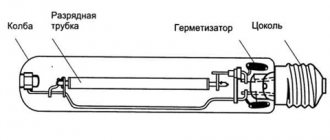In the previous article, we looked at the classification of LEDs by types and types of LEDs. In this material we will consider the question: “Are LEDs really that good?”, “Advantages and disadvantages of LEDs, their pros and cons.” Despite the fact that everywhere there is a lot of information about what are the “positive” sources of solid-state lighting, we were able to collect quite a few “cons”. Even though they do not affect the main component of LEDs - lighting, together it is worth paying attention to this when choosing or switching to diode lighting.
[contents]
I won’t say that my article will be radically different from many others on the Internet. But in it I tried to collect the most complete list of positive and negative aspects, especially those that, as a rule, are not remembered.
—> —>
Advantages and benefits of LEDs
I’ll say right away that there are advantages and disadvantages of LEDs. described in this article are relative in nature. And one cannot categorically draw conclusions from them in one direction or the other.
Of course, the most important positive quality of any LED is low power consumption. In almost every article you can read about this undeniable advantage. For the most part, this statement is 100500 percent true. But even here you can throw a fly in the ointment into the honey tank. It is true that SMD, COB or filament greatly help in saving energy. However, due to the fact that there are quite a large number of counterfeits of Chinese origin on the shelves (without the Chinese), for a small amount of money we can often get unsatisfactory light characteristics. And then there can be no talk of any savings. After all, if we don’t get enough light, we quickly throw away the unnecessary “toy” and return to regular light sources. And therefore there can be no talk of saving.
LED Lifespan
1. The second advantage is the long service life. No manufacturer has exact figures for this characteristic. Everything is only on paper. In fact, the life expectancy of the diode will depend only on the specific operating conditions. But even after comparing different data, we can conclude that most semiconductors are capable of shining from 30,000 to 100,000 hours. In annual terms, this ranges from 10 to 30 years. Such a spread is typical only for manufacturers who do not have their own laboratories and produce products without any quality control. If you look at expensive LED models from well-known manufacturers - Osram, Philips, etc., then their figures can be trusted minus 10 percent. Serious laboratory studies allow us to be sure of this.
Disadvantages of LED lamps
Despite a number of significant advantages of LED, LED lighting has some disadvantages. Just a few years ago, the first place among the disadvantages of LED equipment was its price. But now the cost of the most popular household LED lamps has dropped to an affordable 100-200 rubles. Other functional characteristics came to the fore:
- The disadvantages of LED light sources include the need for a mandatory heat sink for powerful lamps. Their modest dimensions do not allow sufficient heat dissipation; this role is assigned to the built-in radiator. This fact complicates the creation of lamps whose power exceeds 15 W, since the radiator will have impressive dimensions exceeding 100 cm2. In addition, their cost will become much higher;
- Compared to sodium lamps, the luminous flux power of LED devices is somewhat lower, which limits the possibility of their use in street lamps;
- Low-quality lamps, which the domestic market is full of, have one drawback that is dangerous to health: LED lamps flicker during operation, which can negatively affect the health of human eyes. In addition, the blue spectrum of such lamps does not correspond to natural daylight and can cause drowsiness, headaches, and even disrupt a person’s circadian rhythms.
To appreciate the advantages of LED lamps over incandescent, halogen and fluorescent lamps, as well as to avoid the negative consequences of using low-quality products, you should give preference to reliable products from trusted suppliers. Then the risks of material damage and harm to health will be minimized.
Eco-friendly solid state lighting
2.Environmentally friendly. One of the important advantages and advantages of LEDs, because in the era of total control over our health, we often purchase products that cannot harm our already compromised health. According to engineers from any LED companies, not a single chip is produced using toxic materials. Maybe it is so. But the fact that most of the Piranha LEDs were produced on a lead substrate is questioned. We have already written about this fact. And in this case, there can be no question of environmental friendliness.
Operating principle of LEDs
The basis of any LED device is an alloy of elements such as aluminum, gallium and arsenium with the addition of a small amount of semiconductor impurity. Thanks to the latter, the material becomes capable of conducting electric current, with the ability of electrons to move through different atomic orbits. This leads to the effect of luminescence or light generation. In this case, depending on the wavelength of the radiation, a glow of a special shade appears, which is displayed in a wide variety of LED lamps by color temperature.
Important! Ice lamps emit in a wide range of color spectrum - from 1800K to 6000K and above. This advantage makes it possible to significantly expand the scope of their application - from home decor and plant lighting to lighting of industrial facilities. However, this property has a hidden drawback - when choosing an LED lamp of a specific shade, so that it does not cause irritation, you need to have an accurate idea of what effect its glow will have in certain conditions.
Features of the technology
The luminous flux in the ice element is formed from the electric field when charges of different signs arise at the phase boundary (pn junction) when current passes. The semiconductor matrix is covered with a sapphire crystal. However, its natural glow has a bluish tint. Therefore, to generate white light, its surface is coated with a characteristic yellow phosphor (observed on all products).
There are three main types of LED lamps with their own advantages and disadvantages:
- DIP.
- SMD.
- COB.
Disadvantages and disadvantages of LEDs, as well as lamps assembled on them
The main and main drawback is the warranty. The guarantee is not only for LEDs, but also for light sources assembled on their basis. Each lamp manufacturer, in pursuit of its customers, offers a guarantee for the uninterrupted operation of its products for 3-5 years. It’s worth thinking about... Why so little? After all, the service life of the diodes themselves is an order of magnitude higher!!! The answer is simple. Any lamp is not just LEDs. It is a complex device containing numerous electronic components. They are the ones that fail before diodes. So, if the warranty of your lamp is 3 years. and it breaks after three years and one day, then with a high probability you will be left without a lamp and without money. This means you won’t get the “fat plus” in the form of energy savings. The average payback period for a good light source is at least 5 years. It's not pleasant, but tolerable. Especially if you give preference not to cheap fakes, but to high-quality lamps from famous manufacturers.
The first and important drawback is pulsation
1The most annoying problem with LED lamps is flickering. High frequency flickering, pulsation. This is the scourge of today's lamps. We will consider a more detailed description of this problem in one of the following articles. For now, let's take into account that pulsation is the main disadvantage of LED lamps. It often affects Chinese lamps, which use capacitors instead of drivers. And if we take into account the advantages and disadvantages of LEDs (any), then this criterion often plays a role in refusing to purchase LEDs, since many do not know how to deal with pulsation, flickering of LED lamps and diodes themselves.
High price for chips
2Cost of LEDs and lamps. This characteristic has remained and will be relevant for Russian buyers for a long time. For high-quality and expensive LEDs from the famous Nichia, Philips, Osram, the prices are simply amazing. But I want it to be cheap and beautiful))) But in this aspect this is not suitable. In LED lighting, cheap will never be good. Wrong market.
I spent a lot of time building various LED derivatives. And as expected, I bought a large number of chips on the well-known Aliexpress platform. Everything seemed to be fine. Cheap and cheerful. But at that time I was young and green in LED lighting. Somehow I came across diodes from Nichia in the herb... There was no limit to surprise. With the same light power, I received almost three times more than the Chinese ones. This prompted me to think mentally about the advisability of buying Chinese components. But it didn’t last long) I had to look for a “golden mean”, again on Ali. Only through long, painful searches did I manage to find suppliers who sell fairly high-quality diodes for a very reasonable price. Not much worse than the famous ones. If anyone is interested, write and I’ll give you a link. Not cheap. But high quality. Small retail. The advantages and disadvantages of such LEDs will suit everyone.
Driver
3Earlier I already stated that all diode lamps contain a driver. The better the quality of the power source, the more expensive the final cost of the product will be... I will also attribute this to the disadvantages and disadvantages of LEDs. I would like it to be cheaper.
Dimming, Beam Angle and Color Temperature
4Dimming. This can also be attributed to cost. Any LED lamps do not work with dimmers from incandescent lamps. This means you need to buy a new dimmer, and the lamp itself that supports dimming is also not cheap. Again a minus for karma.
5Small scattering angle. Diodes emit light in a narrow direction. In order to get more or less normal light, you have to use secondary optics. Lamps without lenses and collimators look less than respectable. Again costs... Again an increase in cost(.
6.LED lamps are available in different color temperatures. For an apartment you can select from 3500 to 7000K. Without a clear understanding, it is impossible for an uninformed buyer to select a lamp with the desired glow. And most manufacturers do not always indicate the temperature correctly.
7.And one more interesting observation. By purchasing an incandescent lamp each in two stores, we get “bulbs” that are identical in light. In the case of LEDs and LED lamps, this will not work. There are no identical diode lamps in nature. Therefore, two lamps purchased in different stores with the same glow and power will most likely shine differently. Of course, if it happens that the lamps are assembled using diodes of the same brand and were released at the same time, then the distortion will be minimal. But again, this is from the realm of fantasy. Who doesn't believe. Maybe try it. ) As you know, a smart person learns from the mistakes of others. I didn’t have any examples, I checked))) The light show is awesome!)
Advantages of LED lamps and LED luminaires
LED lighting has many positive characteristics. The advantages of LED lamps are many times greater than those of the traditional lighting systems we are used to, which use incandescent, halogen or fluorescent lamps. Therefore, LED lighting is gradually displacing outdated types of lighting devices from the market.
Let's look at the main advantages of LED lamps:
- One of the main advantages of LED lamps is the tangible energy savings of LED lamps. The high light output of these lighting devices is achieved due to the fact that 80% of the energy consumed is converted into light, and only 20% is heat. The outdated option - incandescent lamps - emit up to 85-90% of the energy along with thermal radiation. With such lighting, your financial costs for paying energy bills are significantly reduced.
- Another advantage of LED is the long service life of LED lamps, which is equivalent to 10-11 years of continuous operation. They have a long service life with minimal loss of brightness. For comparison, the average operating time of an LED lamp ranges from 20 to 50 thousand hours, depending on the manufacturer and the components used. Its closest competitors are luminescent devices, for which these indicators vary between 2-90 thousand hours. Today's outdated incandescent lamps can last up to 1000 hours. The service life of halogen lamps is 2000-4000 hours. The obvious advantage of LED lamps over incandescent and halogen lamps is their longer service life.
- The relatively low level of heating is another advantage of LED lamps. LEDs produce a small amount of heat. They hardly heat up during operation, so another advantage of LED lamps is their high fire safety.
- A wide operating temperature range is inherent in all LED devices. Thanks to the high degree of protection from external aggressive factors, they will work both in heat of + 50°C and in frost down to - 40°C.
- Eco-friendliness and safety for health and the environment also distinguish LED lighting from its analogues. Such devices do not contain zinc or mercury, which are used in luminescent or halogen analogs, so their operation and disposal do not pose a threat to consumers and the environment.
- Relatively low weight is another undeniable advantage of LED lamps. They can be used in a wide variety of types of lighting equipment - from mini-lamps and backlights to powerful spotlights.
- An important operational advantage of LED lamps is the flexibility of their use. Based on this technology, a huge number of different types of lighting devices have been created, of different power, light parameters, size, method of application, lamp base format. This includes lamps of various formats, flexible strips and tubes, garlands, spotlights, volumetric light figures and LED ceiling lamps. A variety of lamp form factors (“candle in the wind”, pear-shaped, oval, “mushroom”, “ball”) allows you to find the lamp that best suits your interior.
- Among the advantages of LED lighting is the ability to change the color of RGB lamps. This option allows you to adjust the brightness and color scheme of the device for the specific needs of the consumer: create decorative lighting, get a night light with a weak glow, or illuminate the space as much as possible.
Of particular interest are devices with a concentrated luminous flux - spotlights. Having low weight and small dimensions, such a compact lamp has the ability to produce a powerful light beam. At the same time, the energy consumption of the device is minimal. These advantages of LED floodlights are successfully used in housing and communal services and the manufacturing sector.
Thus, energy efficiency, long service life, large choice of formats and safety are the main advantages of LED lighting.
Advantages and disadvantages of LEDs - conclusions
In principle, despite the fact that there are an order of magnitude more disadvantages and shortcomings than positive aspects, LEDs still have advantages. Both the advantages and disadvantages of LEDs cannot be considered in this case separately from each other in order to get a complete picture of this type of lighting.
Energy saving, ease of installation, long service life, safety, environmental friendliness. The LED industry is developing every day. And what the new day will bring us is unknown. Maybe tomorrow everything will change and I will “change” my favorite LEDs. But for now... For now I am faithful to them, like a young man madly in love with a young lady.
Cons of LED lighting
The disadvantages of diode lighting include the following characteristics:
- The main disadvantage of LEDs is their high cost. Prices continue to decline due to increased mass production. However, they are still several times higher than incandescent light bulbs. A diode analog (in terms of power) of an incandescent lamp for 50-100 rubles will cost at least 300 rubles. It should be noted that, despite the high cost, in the long term, LED products are significantly ahead of their competitors in terms of profitability of the purchase.
- LEDs are not compatible with indicator-type switches or standard dimmers. However, this disadvantage can be circumvented by purchasing a special light bulb suitable for working with a dimmer.
- Although the diodes generate a little heat, this is still enough energy to heat the electronic components of the device. As a result, the driver may fail. Special radiators, purchased separately, help to avoid overheating. However, the cost of the lighting device increases.
So, LED bulbs have relatively few disadvantages. There are clearly more advantages, and they are much more significant.
LEDs - where can they be used?
LED lights, despite their appearance, are almost completely universal, but they are particularly well suited for:
- Main lighting - the correct power of LED lamps and their correct quantity will provide optimal parameters for use as ceiling lighting in almost every room.
- Decorative lighting - LED halogen lamps and LED strips are ideal for illuminating cabinets, stairs, niches and other places that need to be highlighted with light.
- Spot Lighting – LED strip lights, LED bulbs and other types of LED lighting also work well as spot lighting such as tabletop lighting, drawer and cabinet lighting.
Efficient operation in extreme temperatures.
Efficient operation of LEDs
LED lamps can operate effectively both at high air temperatures (40-50 degrees above zero) and at extremely low temperatures (60 degrees below zero).
Moreover, LEDs work even better at low temperatures, which is why they are often used to illuminate freezers and outdoor winter installations.
Base and radiator
LED lamps must match the lamp not only in terms of voltage, but also in terms of base. If you choose one that is too large, the light bulb simply will not fit into the device, and if it is too small, it will not be able to secure itself.
There are several types of bases, but the two most common options are E27 and E14. The first is wide, and the second is quite narrow. It is important to first know which base is required for each lamp in order to choose the right bulb. The shape is no less important, since, for example, spherical options will not fit into every lampshade.
Since LED lamps are practically not resistant to heat, an important issue in relation to them is the presence of a radiator. It removes temperature from the diode block. Often there is no cooling system at all, and sometimes it is made of plastic. Such options should be left aside - it is best to choose a light bulb with an aluminum ribbed surface .
The radiator can only be seen if the light bulb is transparent. You won't be able to see anything through the frosted glass. This is a kind of reason not to buy such options.
Recommendations
So, we've covered the main points. Now the choice is yours. Of course, we recommend not saving on your health and using only pulsation-free lamps for your home. Different people like different types of light. Some people like a warm, homely and cozy light. For some, it’s white and invigorating, like a cold shower. A good solution is to use different source options for different rooms (bedroom, living room, kitchen). We advise you not to purchase lighting products for the entire apartment or house at once, but to illuminate gradually, room by room, experimenting, first of all, with power and color temperature.
And be sure to share the results of your experiments with site readers by leaving a comment.
Summary
There is no doubt that the advantages of LED lamps outweigh the disadvantages. Constant development and improvement of technologies in the manufacture of LED lamps helps to increase efficiency and reduce cost. A high degree of energy efficiency is a relevant aspect in the context of constantly rising energy prices, including electricity. You can discuss the advantages and disadvantages of this lighting technology, but it is worth remembering that energy-saving technologies are the future, and the era of widespread incandescent lamps is coming to an end.
How to get white light using LEDs?
There are three ways to produce white light from LEDs.
The first is color mixing using RGB technology. Red, blue and green LEDs are densely placed on one matrix, the radiation of which is mixed using an optical system, such as a lens. The result is white light.
The second method is that three phosphors are applied to the surface of an LED emitting in the ultraviolet range (there are some), emitting blue, green and red light, respectively. It's similar to how a fluorescent lamp shines.
Finally, in a third method, a yellow-green or green plus red phosphor is applied to a blue LED so that the two or three emissions mix to produce white or near-white light.











